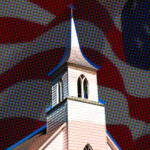This article is one of many informative articles in Joe Carter’s “9 Things You Should Know” series.
In more than half of the states in the U.S., Mormonism is the fastest-growing religion. Although Mormons consider their church to a restorationist movement within Christianity (they believe the Great Apostasy occurred between the time of the New Testament church and it’s restoration under Joseph Smith), Mormonism differs radically from the orthodox Christian teachings and beliefs. Here are nine things you should know about Mormon beliefs:
 1. In 1838, Joseph Smith claims he was told in a revelation that the church should be called The Church of Jesus Christ of Latter-day Saints. Members of the New Testament church were called “saints” (see Acts 9:32, Ephesians 2:19, Philippians 1:1), which is why Mormons call themselves “Latter-day Saints.” As Gordon B. Hinckley, prior president of the LDS church, explains: “They were former-day Saints. We are the Latter-day Saints. It is that simple.” Hinckley adds that they are often called “Mormons” as a nickname given because they believe in the Book of Mormon as the word of God.
1. In 1838, Joseph Smith claims he was told in a revelation that the church should be called The Church of Jesus Christ of Latter-day Saints. Members of the New Testament church were called “saints” (see Acts 9:32, Ephesians 2:19, Philippians 1:1), which is why Mormons call themselves “Latter-day Saints.” As Gordon B. Hinckley, prior president of the LDS church, explains: “They were former-day Saints. We are the Latter-day Saints. It is that simple.” Hinckley adds that they are often called “Mormons” as a nickname given because they believe in the Book of Mormon as the word of God.
2. Mormonism has four written books of scripture: The Book of Mormon: Another Testament of Jesus Christ (which claims to be a record of God’s dealings with the inhabitants of ancient America from 2000 BC to 400 AD), the Doctrine and Covenants (a collection of “revelations and inspired declarations” given for the establishment and regulation of the Church of Jesus Christ in the last days (1830 AD – 1978 AD)), The Pearl of Great Price (a selection of revelations, translations, and writings of Joseph Smith), and the King James Version of the Bible (“We believe the Bible to be the word of God as far as it is translated correctly; we also believe the Book of Mormon to be the word of God.”)
3. The LDS church teaches that as the Bible has been transmitted over the centuries it has “suffered the loss of many plain and precious parts.” They believe the Bible to be the word of God “as far as it is translated correctly” and that the “most reliable way to measure the accuracy of any biblical passage is not by comparing different texts, but by comparison with the Book of Mormon and modern-day revelations.” The KJV is the LDS church’s official English Bible, though it has been foot-noted in a way that interprets the meaning to compliment LDS doctrines.
4. The Book of Mormon teaches that only fools say the Bible is sufficient and that other scripture is not needed (“Thou fool, that shall say: A Bible, we have got a Bible, and we need no more Bible.” (2 Nephi 29:6)). The Book of Mormon contains many linguistic similarities to the King James Bible, including entire passages duplicated word-for-word. For example, the Book of Mormon contains 19 chapters of the King James translation of Isaiah in their entirety.
5. The LDS church subscribes to the doctrine of continual revelation: “We believe all that God has revealed, all that He does now reveal, and we believe that He will yet reveal many great and important things pertaining to the Kingdom of God.” Mormons believe such apostolic revelation is inspired, but not infallible, and can supersede previous revelation, including that found in their scriptures. The only one authorized to bring forth new doctrine is the President of the Church, who, when he does, will declare it as revelation from God, and it will be accepted the church’s First Presidency and Quorum of the Twelve Apostles, and then sustained by the body of the church.
6. Unlike Christian Trinitarianism (one God existing in three Persons), Mormons believe that the Father, Son, and Holy Ghost are three separate gods. They also believe the Father and Son each have a “body of flesh and bones as tangible as man’s” but that the Holy Ghost “has not a body of flesh and bones, but is a personage of Spirit.” According to Joseph Smith, when Adam was formed in the image of God, it was a physical image. God the Father was once a mortal who lived on an earth. He died, was resurrected, glorified, and grew into his deified status. (According to Joseph Smith, there is a “God above the Father of our Lord Jesus Christ.”) God the Father is the literal father of all spirit-children, including Jesus and the Holy Ghost, whose divinity is derived from the parent-child relationship. Within Mormonism, Jesus is identified with the Yahweh of the Old Testament.
7. According to Mormonism, everything in the universe — including God —is ultimately governed by eternal transcendent laws and principles. In LDS teaching, all the Father’s children (including humans) possess the same potential to become gods (like the Father, Jesus, and the Holy Ghost) since they are of the same species. Every human spirit once existed as a divine intelligence before becoming the spirit-children of the Father.
8. Prior to creation human spirits were literal children of heavenly parents. Although their spirits were created, the essential “intelligence” of these spirits is considered eternal, and without beginning. At a family council, God the Father told the spirit-children that according to his “plan of salvation” they would have to leave their heavenly home, take on human bodies, and be tested before they could progress to godhood. Satan rejected this plan and wanted to implement one that would have involved loss of moral agency. Jesus opposed Satan and offered an alternative plan in which he would take on human form and live a sinless life so that his spirit brothers and sisters could become gods. When his plan was not accepted, Lucifer is said to have rebelled and taken “the third part” of the hosts of heaven with him to the earth to serve as tempters.
9. Mormons believe in a universal salvation for everyone from death (this is what they refer to when they speak of “salvation by grace alone.”). But after the body is reunited with the spirit, humans go to different places:
• Celestial Glory — The highest level of the celestial heavenly kingdom is for (married) Mormons who have kept all the Celestial laws and commandments (this is what they refer to by “eternal life”). The lower celestial kingdom is for single Mormons who lived a worthy life and good people (including Christians) who didn’t have a chance on earth to hear about and accept Mormonism. People in this lower group cannot become gods.
• Terrestial Glory — The terrestrial kingdom is for unworthy Mormons and good people who knew about Mormonism on earth but rejected it until after their death.
• Telestial Glory – The telestial realm is for wicked people who rejected Mormonism even after death. They will experience suffering and pain for their sins. It’s similar to the Christian version of Hell, only not eternal.
• Hell (Outer Darkness) – Eternal hell is for Satan, demons, and “sons of perdition” (e.g., those who deny the Holy Spirit after receiving it:).
Note on sources: Wherever possible, I included links directly to official Mormon sources. In other areas I relied on Mormonism Explained; What Latter-day Saints Teach and Practice by Andrew Jackson.
Download your free Christmas playlist by TGC editor Brett McCracken!
 It’s that time of year, when the world falls in love—with Christmas music! If you’re ready to immerse yourself in the sounds of the season, we’ve got a brand-new playlist for you. The Gospel Coalition’s free 2025 Christmas playlist is full of joyful, festive, and nostalgic songs to help you celebrate the sweetness of this sacred season.
It’s that time of year, when the world falls in love—with Christmas music! If you’re ready to immerse yourself in the sounds of the season, we’ve got a brand-new playlist for you. The Gospel Coalition’s free 2025 Christmas playlist is full of joyful, festive, and nostalgic songs to help you celebrate the sweetness of this sacred season.
The 75 songs on this playlist are all recordings from at least 20 years ago—most of them from further back in the 1950s and 1960s. Each song has been thoughtfully selected by TGC Arts & Culture Editor Brett McCracken to cultivate a fun but meaningful mix of vintage Christmas vibes.
To start listening to this free resource, simply click below to receive your link to the private playlist on Spotify or Apple Music.


































